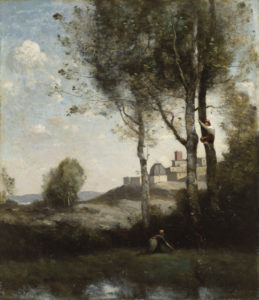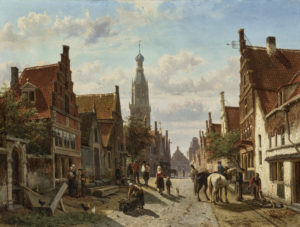
Les dénicheurs Toscans by Jean-Baptiste-Camille Corot
On Tuesday, Christie’s held their European Art online sale, but it was not exactly the best day for fans of nineteenth-century art. 30% of the lots sold below their estimates, while an additional 32% didn’t sell at all. Though estimated to bring in anywhere between $1.76M and $2.62M, sadly, the whole sale only amounted to $1.17M. But while the total may be a bit disappointing, some of the individual lots did very well.
Christie’s specialists did a good job predicting the auction’s top lots. The top spot went to Les dénicheurs Toscans by Jean-Baptiste-Camille Corot. Meaning The Tuscan Scouts, the scene shows a group of people trying to climb a tree. The background features the octagonal Baptistry of San Giovanni, letting the viewer know that Corot set his scene on the outskirts of Volterra, thirty-two miles southwest of Florence. While the title gives off some militaristic connotations, the figures are unlikely to be soldiers. They’re likely just a few boys having a bit of fun, adding just a touch of playfulness to an otherwise serene landscape. Corot’s Italian scene (which had some condition issues) fell nicely within its $100K to $150K estimate, selling for $110K (or $138.6K w/p).

De Vijzelstraat te Enkhuizen by Cornelis Springer
Second place went to De Vijzelstraat te Enkhuizen by the Dutch cityscape painter Cornelis Springer. The street scene (measuring 19 x 26 inches) shows daily life in the small coastal town of Enkhuizen, twenty-eight miles northeast of Amsterdam. The Springer work was estimated to go for $100K to $150K, and it eventually sold for $100K (or $126K w/p). Finally, coming in third was the second of the three Corot paintings featured in the sale. This time, in his Saint-Quentin-des-Prés, he sets his scene in a northern French village rather than a Tuscan walled town. Corot shows a country road with a single cottage and a lone peasant woman. While many of Corot’s contemporaries focused on the French peasantry, Corot here concentrates instead on the rural environment. Christie’s experts believed it would go for anywhere between $120K and $180K, making it the highest-valued work in the pre-sale estimates. While it only brought in $100K (or $126K w/p), it still made the top three lots.

Saint-Quentin-des-Prés by Jean-Baptiste-Camille Corot
Seventeen (27%) of the auction’s lots went unsold in previous sales, but eleven of them finally sold this time around. While six of the eleven sold below their estimates, two sold within and three exceeded the Christie’s specialists’ expectations. Two of them not only exceeded their estimates, but they actually fell within the estimates given to them in their previous sales. The oil-on-canvas painting entitled Vanity by the British Victorian painter Thomas Edwin Mostyn was featured at two previous Christie’s sales. The Mostyn failed to sell at the October 2020 European Art sale with a $40K to $60K estimate, and then was later passed over a second time at the October 2021 European Art sale with a $20K to $30K estimate. This time, Vanity finally sold, surpassing its $18K high estimate, selling for $20K (or $25.2K w/p). Similarly, the Henri-Joseph Harpignies landscape Une vue près de Saint-Privé was featured in the same two Christie’s European Art sales as Mostyn’s Vanity. Like the Mostyn, it failed to sell at its $30K to $50K estimate in 2020, and its $20K to $30K estimate in 2021. And now, the Harpignies landscape joined Vanity’s when it surpassed the $18K high estimate and sold for $22K (or $27.7K w/p). So even though the sale as a whole may have failed to meet expectations, some of the auction’s highlights show that nineteenth-century works can still bring impressive amounts.
Christie’s European Art Online Sale
Les dénicheurs Toscans by Jean-Baptiste-Camille Corot
On Tuesday, Christie’s held their European Art online sale, but it was not exactly the best day for fans of nineteenth-century art. 30% of the lots sold below their estimates, while an additional 32% didn’t sell at all. Though estimated to bring in anywhere between $1.76M and $2.62M, sadly, the whole sale only amounted to $1.17M. But while the total may be a bit disappointing, some of the individual lots did very well.
Christie’s specialists did a good job predicting the auction’s top lots. The top spot went to Les dénicheurs Toscans by Jean-Baptiste-Camille Corot. Meaning The Tuscan Scouts, the scene shows a group of people trying to climb a tree. The background features the octagonal Baptistry of San Giovanni, letting the viewer know that Corot set his scene on the outskirts of Volterra, thirty-two miles southwest of Florence. While the title gives off some militaristic connotations, the figures are unlikely to be soldiers. They’re likely just a few boys having a bit of fun, adding just a touch of playfulness to an otherwise serene landscape. Corot’s Italian scene (which had some condition issues) fell nicely within its $100K to $150K estimate, selling for $110K (or $138.6K w/p).
De Vijzelstraat te Enkhuizen by Cornelis Springer
Second place went to De Vijzelstraat te Enkhuizen by the Dutch cityscape painter Cornelis Springer. The street scene (measuring 19 x 26 inches) shows daily life in the small coastal town of Enkhuizen, twenty-eight miles northeast of Amsterdam. The Springer work was estimated to go for $100K to $150K, and it eventually sold for $100K (or $126K w/p). Finally, coming in third was the second of the three Corot paintings featured in the sale. This time, in his Saint-Quentin-des-Prés, he sets his scene in a northern French village rather than a Tuscan walled town. Corot shows a country road with a single cottage and a lone peasant woman. While many of Corot’s contemporaries focused on the French peasantry, Corot here concentrates instead on the rural environment. Christie’s experts believed it would go for anywhere between $120K and $180K, making it the highest-valued work in the pre-sale estimates. While it only brought in $100K (or $126K w/p), it still made the top three lots.
Saint-Quentin-des-Prés by Jean-Baptiste-Camille Corot
Seventeen (27%) of the auction’s lots went unsold in previous sales, but eleven of them finally sold this time around. While six of the eleven sold below their estimates, two sold within and three exceeded the Christie’s specialists’ expectations. Two of them not only exceeded their estimates, but they actually fell within the estimates given to them in their previous sales. The oil-on-canvas painting entitled Vanity by the British Victorian painter Thomas Edwin Mostyn was featured at two previous Christie’s sales. The Mostyn failed to sell at the October 2020 European Art sale with a $40K to $60K estimate, and then was later passed over a second time at the October 2021 European Art sale with a $20K to $30K estimate. This time, Vanity finally sold, surpassing its $18K high estimate, selling for $20K (or $25.2K w/p). Similarly, the Henri-Joseph Harpignies landscape Une vue près de Saint-Privé was featured in the same two Christie’s European Art sales as Mostyn’s Vanity. Like the Mostyn, it failed to sell at its $30K to $50K estimate in 2020, and its $20K to $30K estimate in 2021. And now, the Harpignies landscape joined Vanity’s when it surpassed the $18K high estimate and sold for $22K (or $27.7K w/p). So even though the sale as a whole may have failed to meet expectations, some of the auction’s highlights show that nineteenth-century works can still bring impressive amounts.